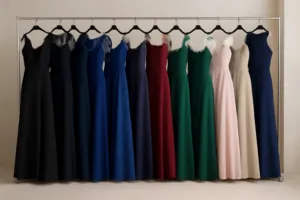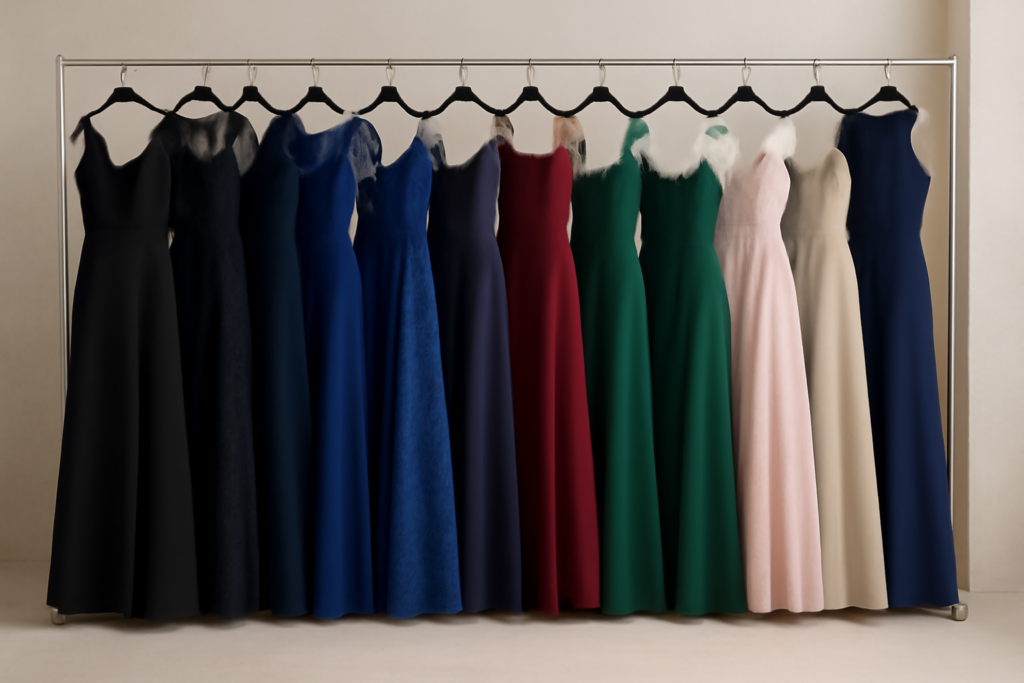Weddings are one of the most significant events in people’s lives, celebrated with great joy, tradition, and style. As a guest, selecting the perfect formal dress for a wedding can often feel like a daunting task. Whether you are attending a lavish celebration or a smaller, intimate gathering, the attire you choose will play a crucial role in your overall experience. This guide will help you navigate the world of wedding attire, offering insight into the various formal dress options, appropriate styles, and key considerations to ensure you look your best while respecting the event’s tone and the couple’s preferences.
Understanding the Wedding Dress Code
Before diving into specific dress styles, it is essential to understand the dress code. Weddings may come with varying levels of formality, and the dress code can often provide guidance on what to wear. The dress code can generally fall into one of several categories, such as:
-
Black Tie: This is the most formal dress code for weddings. For women, this means floor-length evening gowns, typically in elegant fabrics like silk, satin, or chiffon. Men are generally expected to wear a tuxedo with a black bow tie. This dress code is often seen at evening weddings or those held in upscale venues.
-
Black Tie Optional: While still formal, this dress code is slightly more relaxed than black tie. Women have the option of wearing a formal evening gown or an elegant cocktail dress. A floor-length gown is not mandatory, but it is still expected that the attire is sophisticated and chic. Men can wear a tuxedo or a dark suit with a tie.
-
Cocktail Attire: This is a common dress code for evening or semi-formal weddings. Women are typically expected to wear a knee-length cocktail dress or a sophisticated ensemble, while men may wear a suit and tie, though a full tuxedo is not necessary.
-
Casual or Semi-Formal: These weddings are usually less formal and allow for more relaxed attire. Women can wear dressy separates, like a nice blouse paired with a skirt or a midi dress, while men can opt for a blazer and dress trousers or a smart button-up shirt.
-
Daytime or Garden Wedding: These events tend to have a more laid-back atmosphere, but they still require a certain level of formality. Women often wear dresses that are more summery, such as midi or tea-length dresses, while men may wear light-colored suits or blazers.
By understanding the dress code provided by the couple, you can ensure that your outfit is appropriate for the event, both in terms of style and respect for the couple’s wishes.
Types of Formal Dresses for Weddings
When attending a wedding as a guest, choosing the right formal dress can be overwhelming due to the variety of styles, lengths, and fabrics available. Below are some of the most popular types of formal dresses that are suitable for different types of weddings:
1. Floor-Length Gowns
A floor-length gown is often considered the epitome of formal wedding guest attire. This dress style is universally flattering and exudes elegance and sophistication, making it a top choice for black-tie and black-tie optional weddings. There are several variations of the floor-length gown:
-
A-Line Gown: Known for its figure-flattering silhouette, the A-line gown is perfect for most body types. It typically has a fitted bodice that flows into a gentle flare from the waist down, resembling the shape of an “A.”
-
Mermaid Gown: A mermaid gown hugs the body closely from the chest down to the knees, then flares out dramatically. This style is perfect for women who want to highlight their curves while maintaining a formal look.
-
Ball Gown: The ball gown is characterized by a full skirt and fitted bodice. This is a classic princess-style dress that provides dramatic volume and is often associated with a more extravagant wedding.
-
Sheath Gown: A sleek and narrow option, the sheath gown skims the body’s natural shape. It is a great choice for those who prefer a minimalist look without compromising elegance.
2. Cocktail Dresses
For weddings with a “cocktail attire” or “semi-formal” dress code, a cocktail dress is an excellent choice. This dress is typically knee-length and comes in various styles, making it versatile for different body types and personal preferences.
-
Fit-and-Flare Cocktail Dress: A classic option that fits closely at the waist and flares out toward the hemline. It’s both elegant and flattering and can be dressed up with accessories.
-
Sheath Cocktail Dress: This form-fitting dress follows the natural shape of the body, creating a streamlined and sleek silhouette. It’s perfect for evening weddings where a more sophisticated look is desired.
-
Tea-Length Dress: With a hemline that falls between the knee and the ankle, the tea-length dress provides a vintage vibe. It’s an ideal choice for afternoon weddings or those with a more retro-inspired theme.
3. Maxi Dresses
Maxi dresses are versatile and comfortable, typically falling just above the ankle. While they can be worn casually or formally, their length and styling options can make them appropriate for a wide variety of wedding types.
-
Flowing Maxi Dress: A flowing, loose-fitting maxi dress made of lighter fabrics such as chiffon or silk is perfect for a daytime or garden wedding, especially if the event is outdoors.
-
Structured Maxi Dress: With a more fitted bodice and sleek design, structured maxi dresses can be appropriate for formal weddings that allow for a more relaxed dress code.
4. Jumpsuits and Pantsuits
In recent years, jumpsuits and pantsuits have emerged as stylish alternatives to traditional dresses. For women who prefer a modern, bold look, a well-tailored jumpsuit or pantsuit can be just as formal and elegant as a gown.
-
Tailored Jumpsuit: A well-fitted jumpsuit with sophisticated details such as a plunging neckline, wide legs, or a belted waist can offer a chic, fashion-forward look for weddings.
-
Pantsuit: If you prefer a two-piece option, a formal pantsuit in luxurious fabrics like silk or satin can be an elegant choice, particularly for black-tie optional events.
5. Dressy Separates
Some women prefer the option of dressy separates, which allow for more personalization and flexibility. These may include a formal blouse paired with a long skirt or tailored trousers, or a sophisticated top with a pencil skirt. Dressy separates are perfect for women who wish to mix and match items while still maintaining a formal and polished appearance.
-
Peplum Top and Pencil Skirt: The peplum top adds a feminine touch with its ruffled waistline, while the pencil skirt creates a slim silhouette. This look is ideal for a cocktail or semi-formal wedding.
-
Brocade Skirt and Silk Blouse: Pairing a luxurious fabric like brocade with a soft silk blouse can create a sophisticated look suitable for a formal event.
Choosing the Right Fabric
The fabric of your formal wedding dress plays a significant role in its overall look and feel. Some fabrics are better suited for certain seasons, while others exude more elegance or glamour. Consider the wedding season, location, and time of day when selecting the fabric for your dress:
-
Satin and Silk: These luxurious fabrics are often associated with evening or black-tie weddings due to their smooth, shiny finish. They are perfect for a classic, elegant look.
-
Chiffon and Tulle: Light and airy, chiffon and tulle are excellent choices for daytime or summer weddings. These fabrics are often used in dresses with flowing silhouettes or layers.
-
Brocade and Jacquard: Rich and textured, these fabrics are great for winter or formal weddings. The intricate patterns add depth and elegance to the dress.
-
Lace: Lace dresses can range from delicate and soft to bold and dramatic. A lace overlay or lace detailing can elevate any dress and is often chosen for more romantic or vintage-inspired weddings.
Key Considerations When Choosing a Wedding Guest Dress
-
Avoid White, Off-White, or Ivory: Traditionally, white is reserved for the bride, so it’s important to avoid wearing white or any color that could overshadow the bride’s dress. Instead, opt for rich jewel tones, pastels, or neutral shades.
-
Respect the Couple’s Wishes: If the couple has specified a certain dress code, it is essential to follow it. Some couples may request specific colors or themes, so be sure to adhere to those guidelines to avoid any fashion faux pas.
-
Comfort is Key: Weddings often involve long hours, so it’s important to choose a dress that is comfortable. Look for fabrics that breathe well, avoid overly tight-fitting dresses, and consider shoes that will keep your feet comfortable throughout the day.
-
Accessories: Jewelry, shoes, and handbags are the perfect way to add personality to your look. Choose accessories that complement your dress and the wedding’s formality. Statement earrings, a clutch bag, and elegant heels can elevate your overall appearance.
Conclusion
Selecting the perfect formal dress for a wedding involves balancing style, appropriateness, and comfort. By considering the event’s dress code, the type of wedding, and your personal taste, you can ensure that your choice enhances the celebration while maintaining respect for the couple’s wishes. Whether you opt for a classic gown, a modern jumpsuit, or an elegant cocktail dress, the right formal attire will help you feel confident, stylish, and ready to celebrate one of life’s most beautiful occasions.




